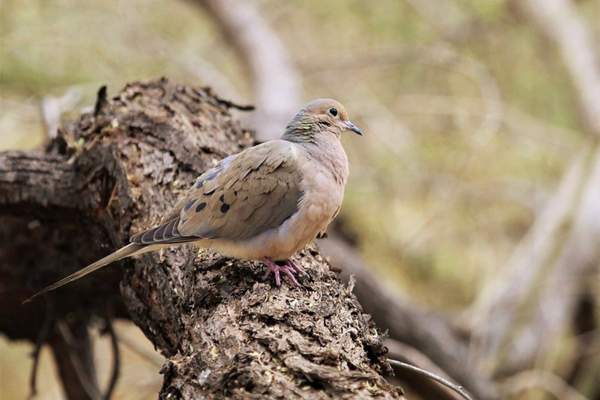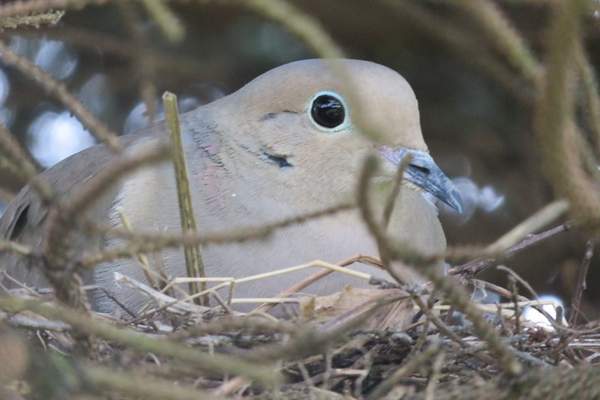Common Name: Mourning Dove
Scientific Name: Zenaida macroura| Size | Diet | Range in Hawaii | Status in Hawaii |
|---|---|---|---|
| 10 in. | variety of plants, including grasses, weeds, and grains | All Islands | least concern |
The mourning dove (Zenaida macroura) is a common bird species found throughout much of North and Central America. It is a medium-sized bird, with a slender body and long, pointed tail. It is predominantly pale gray in color, with a black patch on the back of its neck. The mourning dove is known for its distinctive cooing call, which is a series of soft, mournful hoots that are often heard at dawn and dusk.
Mourning dove
Appearance

Mourning doves are medium-sized birds with a slender body and a long, tapered tail. They have a pale, gray-brown plumage on their upperparts, with darker feather markings on their wings and tail.
The underparts of their body are pale pink or beige in color. They have a distinctive black spot on the side of their neck, and their head is small and rounded, with a small, thin bill.
Mourning doves have a pale, pinkish fleshy crown on the top of their head, which becomes more pronounced during the breeding season. Their legs and feet are also pale in color.
Adult males and females are similar in size and appearance, although males may be slightly larger. Juvenile mourning doves have a more mottled, brownish plumage, which becomes more uniform in color as they mature.
The size of a mourning dove can vary depending on the specific subspecies and location, but most individuals are around 10 inches (25 cm) in length, with a wingspan of about 13 inches (33 cm).
Diet
Mourning doves are seed-eating birds that primarily feed on seeds from a variety of plants, including grasses, weeds, and grains. They are opportunistic feeders and will also eat insects, particularly during the breeding season when they need to provide protein to their young. In urban areas, they may also eat birdseed from feeders.
Behavior
Mourning doves are social birds and are often seen in pairs or small flocks. They are known for their graceful, undulating flight, and can often be heard flying overhead, making a distinctive “whoo-OO-whoo” sound with their wings.
During the breeding season, male mourning doves perform elaborate courtship displays, including cooing and bowing to attract a mate. Both male and female mourning doves share in the duties of building a nest and raising their young. Mourning doves are generally peaceful and non-aggressive birds, but they will defend their territory and nests from intruders.
Nesting

Mourning doves build their nests out of twigs, grasses, and other plant material, and typically place them in trees, shrubs, or on ledges. The male and female work together to construct the nest, which is a flimsy, shallow platform that can be as small as six inches in diameter.
Once the nest is built, the female lays two eggs, which are incubated by both parents for about two weeks. The eggs are small, white, and slightly pointed at one end, and are often laid a day or two apart. The female usually does the majority of the incubating, while the male brings her food and keeps an eye out for predators.
After the eggs hatch, the chicks, called squabs, are fed a protein-rich substance called “pigeon milk” produced by the parents. The young birds fledge (leave the nest) after about two weeks, and are fed by the parents for an additional week or so before becoming independent.
Habitat
Mourning doves prefer open areas with some trees or shrubs for cover, and are often found near sources of water. They are adaptable birds that are able to thrive in a range of environments, and can be found in both rural and urban areas. They are a common sight in gardens, parks, and open woodlands, and are also found in a variety of other habitats including grasslands, scrublands, and agricultural areas.
Range
Mourning doves are not native to Hawaii. The species was introduced to Hawaii in the late 1800s and early 1900s, and is now found on all of the main islands. However, their distribution in Hawaii is likely limited by the availability of suitable habitat and other factors.
Conservation Status
The mourning dove is a common bird species found throughout much of North and Central America. It is not considered to be at risk of extinction, and it is classified as a species of “Least Concern” by the International Union for Conservation of Nature (IUCN).
Interesting Facts
1. Known for its distinctive cooing call
The cooing call of the mourning dove is often described as a soothing and peaceful sound, and it is a common feature of the natural soundscape in many parts of its range.
2. Popular game bird
The mourning dove is a popular game bird and is hunted in many parts of its range, including Hawaii.
3. Popular subject in Hawaiian folklore and mythology
The mourning dove is a popular subject in Hawaiian folklore and mythology. In some stories, it is said to be a messenger of the gods or a symbol of peace and goodwill.
4. Useful indicator
The mourning dove is a useful indicator of the health of Hawaiian ecosystems. Its presence or absence in an area can provide important information about the availability of food and habitat, as well as the overall health of the ecosystem.
Frequently Asked Questions:
What do mourning doves eat?
The mourning dove feeds on a variety of seeds and grains, which it collects from the ground or from plants. It is an important seed disperser and helps to spread the seeds of native plants throughout its range.
Are mourning doves protected in Hawaii?
The mourning dove is not considered to be at risk of extinction and is classified as a species of “Least Concern” by the International Union for Conservation of Nature (IUCN). However, it is protected by state and federal laws in the United States, which prohibit hunting or possession of the species without a permit.
Are there any threats to mourning doves in Hawaii?
The mourning dove is a widespread and adaptable species that is not currently considered to be facing significant threats in Hawaii. However, like all species, it may be affected by habitat loss, disease, or other factors that could potentially impact its population.




